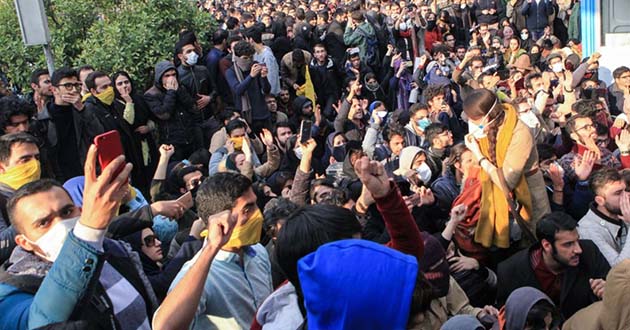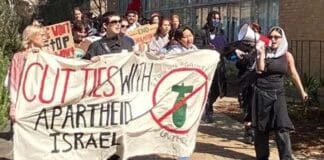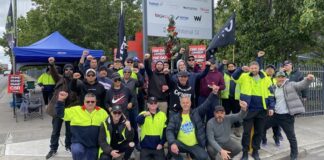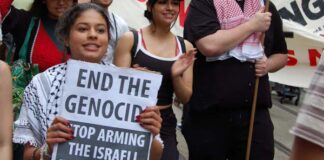The wave of mass protests in Iran that began in late December has spread to all corners of the country. At least 22 people have been killed and more than 1500 arrested.
This is the largest display of public defiance since 2009—when protests led by the largely middle class residents of Tehran against electoral fraud were brutally repressed. This time the revolt has been strongest in cities with a large impoverished working class.
The regime has hit back, deploying its Revolutionary Guards to savagely repress the movement. It has also called pro-government protests of its own.
Last Wednesday General Mohammad Ali Jafari, the head of the Revolutionary Guards, wishfully declared the unrest over, announcing, “the end of the sedition”.
But the protests, and nightly pitched battles with the security forces, are continuing.
The initial protest in Mashhad, Iran’s second largest city, was organised by regime hardliners in an attempt to undermine “reformist” president Hassan Rouhani. But it was taken over immediately by ordinary people looking to voice their frustration over unemployment and economic hardship.
Since then spontaneous protests have erupted in nearly 70 cities, many in provincial areas where there is high unemployment.
The immediate catalyst for popular rage was the annual budget, where Rouhani’s government handed billions to clerical institutions and the military, while cutting subsidies for the poor. The economy has actually started to recover, following the easing of sanctions and the resumption of oil exports. But the mass of poor people have barely benefitted.
Price rises, including a 40 per cent jump in the price of eggs, unemployment officially at 12 per cent but in reality much higher, unpaid wages and rocketing rents have all made life harder for ordinary people. Many retirees haven’t received their pensions, and others have lost money because the banks went bankrupt.
Unlike those in 2009 the protests have raised slogans against both factions of the regime: the liberal “reformers” and the conservative hardliners. Despite its religious framework the Iranian regime is fundamentally capitalist. Both factions have imposed neo-liberal austerity and embarked on privatisation in an effort to attract foreign investors and restore relations in the West.
Chants have included both “Death to the Dictator”, targeting Supreme Leader Ali Khamenei and “Death to Rouhani”. Representatives of all factions, from Rouhani allies to senior ayatollahs, are deeply mired in corruption. Former conservative president Mahmoud Ahmadinejad is currently facing serious charges.
Protesters have also opposed Iranian government spending on wars in Syria and Iraq while ordinary Iranians suffer poverty, with chants including “Forget about Syria—think about us”.
There have been calls for independent trade unions, and, in Arab Spring style, the fall of the regime. Women have been at the forefront of the protests, often defying the compulsory wearing of the hijab.
As in any real movement there are also conflicting ideas. There have been some nationalist slogans raised such as “Neither Gaza, nor Lebanon, I give my life for Iran” and “We are Aryans, we don’t worship Arabs”.
Don’t trust Trump, no to the monarchy
Donald Trump has positioned himself as a saviour of the Iranian masses. Nothing could be further from the truth. Iranians are among those banned from entering the US under Trump’s travel ban. He has slashed the refugee quota, and is intent on undermining the deal over Iran’s nuclear program which has eased sanctions.
The Australian government also wants to keep out Iranian refugees, many of whom fled the regime’s crackdown on the 2009 protests. It has imprisoned hundreds of Iranian asylum seekers on Manus Island and Nauru. Western governments are no friends of ordinary Iranians struggling for freedom. They simply hope to replace the Iranian regime with a government supportive of US and Western control of the Middle East.
And it is an insult to the brave protesters to present them as somehow manipulated by the US and Israel.
Some reports have focused on the right wing minority who call for the monarchy’s restoration. Shah supporters are prominent among exile communities in the West, but their influence in Iran is far weaker. In the northern city of Rasht, when some in the crowd shouted pro-Shah slogans, others responded by calling for an Iranian republic (as opposed to an Islamic Republic).
Workers’ movement
In the mass revolutionary wave that overthrew the Shah in 1979, workers played a central role. Workers councils, known as shora, were set up. However, the largest left party at the time, the Stalinist Tudeh Party, sought an alliance with Ayatollah Khomeini, seeing him as somehow progressive. The left and the workers’ movement paid a heavy price for this mistake, as Khomeini quickly and savagely suppressed all expressions of independent working class organisation in an effort to restabilise Iranian capitalism.
Workers in Iran continue to resist the privatisation of the steel and oil industries, the widespread use of sub-contracting, the use of the Revolutionary Guard to suppress dissent, and the imprisonment of union leaders.
The Alliance of Middle East Socialists has reported: “There have been protests, workers strikes, almost every day in last few years in Iran. But none of them could connect to each other to make a general and massive popular uprising like now.”
An Agence France-Presse report says, “Minor protests have been bubbling away in the weeks leading up to the current unrest,” with “hundreds of oil workers and truck drivers protesting the late payment of wages; tractor makers in Tabriz against their factory’s closure; and Tehran tire workers at bonuses being delayed.”
On Boxing Day—two days before the mass protests erupted—a protest outside the Ministry of Labour in Tehran over the deteriorating health of Reza Shahabi (the jailed treasurer of the Tehran and Suburbs bus union) was brutally attacked by security forces.
Teachers have taken strike action and rallied across the country, demanding increased pay and an improvement to the education system.
Trade unionists in Australia have a role to play in supporting workers’ struggles in Iran. The British trade union movement has put out a statement urging international solidarity.
Persian nationalism is strong in Iran, but the fact the the revolt is occurring in areas with strong Kurdish, Arab and Baluchi populations is very encouraging.
Some of the largest protests have occurred in the mostly Arab-speaking province of Khuzestan, which is also the centre of Iran’s oil production. In the city of Izeh, the people apparently have taken over the entire city.
A mass uprising in Iran could undermine the bitter sectarianism between Shia and the Sunni that has been a feature of the Middle East over recent years. Syrian and Egyptian revolutionaries for example, have already been inspired by the revolt. A mass uprising of the Iranian working class demanding freedom and an end to inequality would inspire workers across the region to fight their own ruling classes. Egypt in particular, which was at the heart of the Arab Spring, has a large working class that has fought to build independent trade unions.
As the seventh anniversary of the Arab Spring approaches, a mass upheaval in Iran holds the potential to reignite the hopes and dreams for a socialist Middle East.
By Mark Goudkamp






